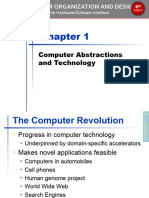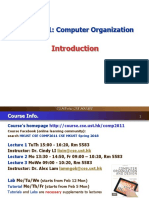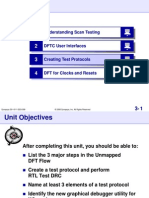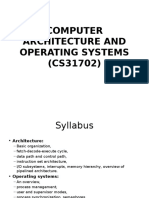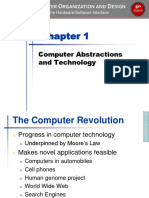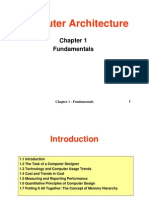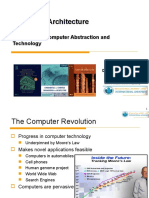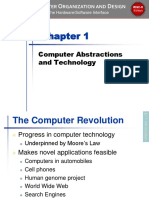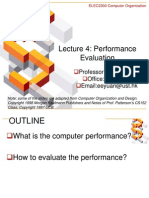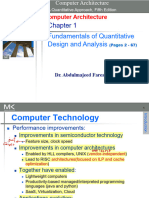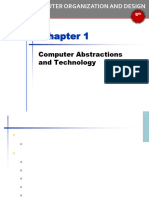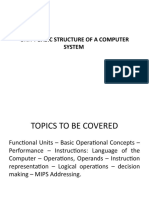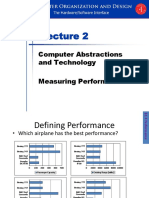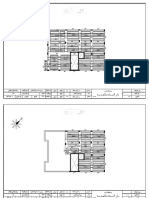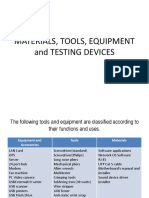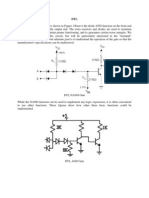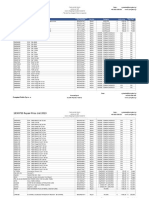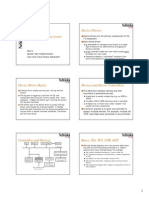Computer Abstractions and Technology: Adapted by Prof. Gheith Abandah
Computer Abstractions and Technology: Adapted by Prof. Gheith Abandah
Uploaded by
asaa sdafCopyright:
Available Formats
Computer Abstractions and Technology: Adapted by Prof. Gheith Abandah
Computer Abstractions and Technology: Adapted by Prof. Gheith Abandah
Uploaded by
asaa sdafOriginal Title
Copyright
Available Formats
Share this document
Did you find this document useful?
Is this content inappropriate?
Copyright:
Available Formats
Computer Abstractions and Technology: Adapted by Prof. Gheith Abandah
Computer Abstractions and Technology: Adapted by Prof. Gheith Abandah
Uploaded by
asaa sdafCopyright:
Available Formats
COMPUTER ORGANIZATION AND DESIGN RISC-V
Edition
The Hardware/Software Interface
Chapter 1
Computer Abstractions
and Technology
Adapted by Prof. Gheith Abandah
Content
1.2 Eight Great Ideas in Computer Architecture
(Review)
1.5 Technologies for Building Processors and
Memory
1.6 Performance (Review)
1.7 The Power Wall
1.8 The Sea Change: The Switch from
Uniprocessors to Multiprocessors
1.9 Real Stuff: Benchmarking the Intel Core i7
1.10 Fallacies and Pitfalls
1.11 Concluding Remarks
Chapter 1 — Computer Abstractions and Technology — 2
§1.2 Eight Great Ideas in Computer Architecture
Eight Great Ideas
Design for Moore’s Law
Use abstraction to simplify design
Make the common case fast
Performance via parallelism
Performance via pipelining
Performance via prediction
Hierarchy of memories
Dependability via redundancy
Chapter 1 — Computer Abstractions and Technology — 3
Content
1.2 Eight Great Ideas in Computer Architecture
(Review)
1.5 Technologies for Building Processors and
Memory
1.6 Performance (Review)
1.7 The Power Wall
1.8 The Sea Change: The Switch from
Uniprocessors to Multiprocessors
1.9 Real Stuff: Benchmarking the Intel Core i7
1.10 Fallacies and Pitfalls
1.11 Concluding Remarks
Chapter 1 — Computer Abstractions and Technology — 4
§1.5 Technologies for Building Processors and Memory
Technology Trends
Electronics
technology
continues to evolve
Increased capacity
and performance
Reduced cost
DRAM capacity
Year Technology Relative performance/cost
1951 Vacuum tube 1
1965 Transistor 35
1975 Integrated circuit (IC) 900
1995 Very large scale IC (VLSI) 2,400,000
2013 Ultra large scale IC 250,000,000,000
Chapter 1 — Computer Abstractions and Technology — 5
Semiconductor Technology
Silicon: semiconductor
Add materials to transform properties:
Conductors
Insulators
Switch
Chapter 1 — Computer Abstractions and Technology — 6
Manufacturing ICs
Yield: proportion of working dies per wafer
Chapter 1 — Computer Abstractions and Technology — 7
Intel Core i7 Wafer
300mm wafer, 280 chips, 32nm technology
Each chip is 20.7 x 10.5 mm
Chapter 1 — Computer Abstractions and Technology — 8
Integrated Circuit Cost
Cost per wafer
Cost per die
Dies per wafer Yield
Dies per wafer Wafer area Die area
1
Yield
(1 (Defects per area Die area/2)) 2
Nonlinear relation to area and defect rate
Wafer cost and area are fixed
Defect rate determined by manufacturing process
Die area determined by architecture and circuit design
Chapter 1 — Computer Abstractions and Technology — 9
Content
1.2 Eight Great Ideas in Computer Architecture
(Review)
1.5 Technologies for Building Processors and
Memory
1.6 Performance (Review)
1.7 The Power Wall
1.8 The Sea Change: The Switch from
Uniprocessors to Multiprocessors
1.9 Real Stuff: Benchmarking the Intel Core i7
1.10 Fallacies and Pitfalls
1.11 Concluding Remarks
Chapter 1 — Computer Abstractions and Technology — 10
Response Time and Throughput
Response time
How long it takes to do a task
Throughput
Total work done per unit time
e.g., tasks/transactions/… per hour
How are response time and throughput affected
by
Replacing the processor with a faster version?
Adding more processors?
We’ll focus on response time for now…
Chapter 1 — Computer Abstractions and Technology — 11
Relative Performance
Define Performance = 1/Execution Time
“X is n time faster than Y”
Performanc e X Performanc e Y
Execution time Y Execution time X n
Example: time taken to run a program
10s on A, 15s on B
Execution TimeB / Execution TimeA
= 15s / 10s = 1.5
So A is 1.5 times faster than B
Chapter 1 — Computer Abstractions and Technology — 12
Measuring Execution Time
Elapsed time
Total response time, including all aspects
Processing, I/O, OS overhead, idle time
Determines system performance
CPU time
Time spent processing a given job
Discounts I/O time, other jobs’ shares
Comprises user CPU time and system CPU
time
Different programs are affected differently by
CPU and system performance
Chapter 1 — Computer Abstractions and Technology — 13
CPU Clocking
Operation of digital hardware governed by a
constant-rate clock
Clock period
Clock (cycles)
Data transfer
and computation
Update state
Clock period: duration of a clock cycle
e.g., 250ps = 0.25ns = 250×10–12s
Clock frequency (rate): cycles per second
e.g., 4.0GHz = 4000MHz = 4.0×109Hz
Chapter 1 — Computer Abstractions and Technology — 14
CPU Time
CPU Time CPU Clock Cycles Clock Cycle Time
CPU Clock Cycles
Clock Rate
Performance improved by
Reducing number of clock cycles
Increasing clock rate
Hardware designer must often trade off clock
rate against cycle count
Chapter 1 — Computer Abstractions and Technology — 15
Instruction Count and CPI
Clock Cycles Instructio n Count Cycles per Instructio n
CPU Time Instructio n Count CPI Clock Cycle Time
Instructio n Count CPI
Clock Rate
Instruction Count for a program
Determined by program, ISA and compiler
Average cycles per instruction
Determined by CPU hardware
If different instructions have different CPI
Average CPI affected by instruction mix
Chapter 1 — Computer Abstractions and Technology — 16
CPI in More Detail
If different instruction classes take different
numbers of cycles
n
Clock Cycles (CPIi Instructio n Count i )
i1
Weighted average CPI
Clock Cycles n
Instructio n Count i
CPI CPIi
Instructio n Count i1 Instructio n Count
Relative frequency
Chapter 1 — Computer Abstractions and Technology — 17
Performance Summary
The BIG Picture
Instructio ns Clock cycles Seconds
CPU Time
Program Instructio n Clock cycle
Performance depends on
Algorithm: affects IC, possibly CPI
Programming language: affects IC, CPI
Compiler: affects IC, CPI
Instruction set architecture: affects IC, CPI, Tc
Chapter 1 — Computer Abstractions and Technology — 18
Content
1.2 Eight Great Ideas in Computer Architecture
(Review)
1.5 Technologies for Building Processors and
Memory
1.6 Performance (Review)
1.7 The Power Wall
1.8 The Sea Change: The Switch from
Uniprocessors to Multiprocessors
1.9 Real Stuff: Benchmarking the Intel Core i7
1.10 Fallacies and Pitfalls
1.11 Concluding Remarks
Chapter 1 — Computer Abstractions and Technology — 19
§1.7 The Power Wall
Power Trends
In CMOS IC technology
Power Capacitive load Voltage 2 Frequency
×30 5V → 1V ×1000
Chapter 1 — Computer Abstractions and Technology — 20
Reducing Power
Suppose a new CPU has
85% of capacitive load of old CPU
15% voltage and 15% frequency reduction
Pnew Cold 0.85 (Vold 0.85) 2 Fold 0.85
0.85 4
0.52
Cold Vold Fold
2
Pold
The power wall
We can’t reduce voltage further
We can’t remove more heat
How else can we improve performance?
Chapter 1 — Computer Abstractions and Technology — 21
Content
1.2 Eight Great Ideas in Computer Architecture
(Review)
1.5 Technologies for Building Processors and
Memory
1.6 Performance (Review)
1.7 The Power Wall
1.8 The Sea Change: The Switch from
Uniprocessors to Multiprocessors
1.9 Real Stuff: Benchmarking the Intel Core i7
1.10 Fallacies and Pitfalls
1.11 Concluding Remarks
Chapter 1 — Computer Abstractions and Technology — 22
§1.8 The Sea Change: The Switch to Multiprocessors
Uniprocessor Performance
Constrained by power, instruction-level parallelism,
memory latency
Chapter 1 — Computer Abstractions and Technology — 23
Multiprocessors
Multicore microprocessors
More than one processor per chip
Requires explicitly parallel programming
Compare with instruction level parallelism
Hardware executes multiple instructions at once
Hidden from the programmer
Hard to do
Programming for performance
Load balancing
Optimizing communication and synchronization
Chapter 1 — Computer Abstractions and Technology — 24
Content
1.2 Eight Great Ideas in Computer Architecture
(Review)
1.5 Technologies for Building Processors and
Memory
1.6 Performance (Review)
1.7 The Power Wall
1.8 The Sea Change: The Switch from
Uniprocessors to Multiprocessors
1.9 Real Stuff: Benchmarking the Intel Core i7
1.10 Fallacies and Pitfalls
1.11 Concluding Remarks
Chapter 1 — Computer Abstractions and Technology — 25
SPEC CPU Benchmark
Programs used to measure performance
Supposedly typical of actual workload
Standard Performance Evaluation Corp (SPEC)
Develops benchmarks for CPU, I/O, Web, …
SPEC CPU2006
Elapsed time to execute a selection of programs
Negligible I/O, so focuses on CPU performance
Normalize relative to reference machine
Summarize as geometric mean of performance ratios
CINT2006 (integer) and CFP2006 (floating-point)
n
n
Execution time ratio
i1
i
Chapter 1 — Computer Abstractions and Technology — 26
CINT2006 for Intel Core i7 920
Chapter 1 — Computer Abstractions and Technology — 27
SPEC Power Benchmark
Power consumption of server at different
workload levels
Performance: ssj_ops/sec
Power: Watts (Joules/sec)
10 10
Overall ssj_ops per Watt ssj_ops i power i
i0 i0
Chapter 1 — Computer Abstractions and Technology — 28
SPECpower_ssj2008 for Xeon X5650
Chapter 1 — Computer Abstractions and Technology — 29
Content
1.2 Eight Great Ideas in Computer Architecture
(Review)
1.5 Technologies for Building Processors and
Memory
1.6 Performance (Review)
1.7 The Power Wall
1.8 The Sea Change: The Switch from
Uniprocessors to Multiprocessors
1.9 Real Stuff: Benchmarking the Intel Core i7
1.10 Fallacies and Pitfalls
1.11 Concluding Remarks
Chapter 1 — Computer Abstractions and Technology — 30
§1.10 Fallacies and Pitfalls
Pitfall: Amdahl’s Law
Improving an aspect of a computer and
expecting a proportional improvement in
overall performance
Taffected
Timproved Tunaffected
improvemen t factor
Example: multiply accounts for 80s/100s
How much improvement in multiply performance to
get 5× overall?
80 Can’t be done!
20 20
n
Corollary: make the common case fast
Chapter 1 — Computer Abstractions and Technology — 31
Fallacy: Low Power at Idle
Look back at i7 power benchmark
At 100% load: 258W
At 50% load: 170W (66%)
At 10% load: 121W (47%)
Google data center
Mostly operates at 10% – 50% load
At 100% load less than 1% of the time
Consider designing processors to make
power proportional to load
Chapter 1 — Computer Abstractions and Technology — 32
Pitfall: MIPS as a Performance Metric
MIPS: Millions of Instructions Per Second
Doesn’t account for
Differences in ISAs between computers
Differences in complexity between instructions
Instructio n count
MIPS
Execution time 10 6
Instructio n count Clock rate
Instructio n count CPI CPI 10 6
10 6
Clock rate
CPI varies between programs on a given CPU
Chapter 1 — Computer Abstractions and Technology — 33
Content
1.2 Eight Great Ideas in Computer Architecture
(Review)
1.5 Technologies for Building Processors and
Memory
1.6 Performance (Review)
1.7 The Power Wall
1.8 The Sea Change: The Switch from
Uniprocessors to Multiprocessors
1.9 Real Stuff: Benchmarking the Intel Core i7
1.10 Fallacies and Pitfalls
1.11 Concluding Remarks
Chapter 1 — Computer Abstractions and Technology — 34
§1.11 Concluding Remarks
Concluding Remarks
Cost/performance is improving
Due to underlying technology development
Execution time: the best performance
measure
Power is a limiting factor
Use parallelism to improve performance
Chapter 1 — Computer Abstractions and Technology — 35
You might also like
- Patterson6e MIPS Ch01 PPTDocument49 pagesPatterson6e MIPS Ch01 PPTalapabainviNo ratings yet
- Chapter 01 Computer Organization and Design, Fifth Edition: The Hardware/Software Interface (The Morgan Kaufmann Series in Computer Architecture and Design) 5th EditionDocument49 pagesChapter 01 Computer Organization and Design, Fifth Edition: The Hardware/Software Interface (The Morgan Kaufmann Series in Computer Architecture and Design) 5th EditionPriyanka Meena83% (6)
- Exp No. 3: Design of 8-Bit Arithmetic Logic Unit (ALU)Document5 pagesExp No. 3: Design of 8-Bit Arithmetic Logic Unit (ALU)DaniaNo ratings yet
- Chapter 1: Computer Abstractions and TechnologyDocument50 pagesChapter 1: Computer Abstractions and TechnologyGreen ChiquitaNo ratings yet
- Computer Organization and Design 4th Edition Chapter 1 SlidesDocument9 pagesComputer Organization and Design 4th Edition Chapter 1 SlidesMark PerkinsNo ratings yet
- Alllpdf PDFDocument253 pagesAlllpdf PDFYousef MomaniNo ratings yet
- Lecture 1 COMP2611 Introduction Spring2018Document34 pagesLecture 1 COMP2611 Introduction Spring2018jnfzNo ratings yet
- DFT ProtocolDocument33 pagesDFT Protocolnoor_dcet100% (1)
- Chapter 1 - Fundamentals of Computer DesignDocument40 pagesChapter 1 - Fundamentals of Computer Designarchumeenabalu100% (1)
- Chapter 1 Fundamentals of Computer DesignDocument40 pagesChapter 1 Fundamentals of Computer DesignAbdullahNo ratings yet
- CH 1Document55 pagesCH 1Wei-Lun HuangNo ratings yet
- Computer Architecture and Operating Systems (CS31702)Document30 pagesComputer Architecture and Operating Systems (CS31702)Arafat KhanNo ratings yet
- Chapter 1 Computer Abstractions and TechnologyDocument46 pagesChapter 1 Computer Abstractions and TechnologyOmar Bin MohammedNo ratings yet
- Chapter 1 COALDocument46 pagesChapter 1 COALShahzael MughalNo ratings yet
- Chapter 1 Part 2: Computer Abstractions and TechnologyDocument27 pagesChapter 1 Part 2: Computer Abstractions and TechnologyAfs AsgNo ratings yet
- Comp OrganizationDocument49 pagesComp Organizationmanas0% (1)
- Chapter 1 Computer Abstractions and TechnologyDocument46 pagesChapter 1 Computer Abstractions and TechnologyRony CudiJr PolisaintNo ratings yet
- Computer Abstractions and TechnologyDocument47 pagesComputer Abstractions and TechnologyShyamala RamachandranNo ratings yet
- Chapter 01Document20 pagesChapter 01mostafayounis630No ratings yet
- Lecture - 4 - PerformanceDocument31 pagesLecture - 4 - PerformanceAbhishek kumarNo ratings yet
- Chapter 01Document49 pagesChapter 01deepaknittrichyNo ratings yet
- Computer Architecture and Operating Systems (Caos) Course Code: CS31702 4-0-0Document33 pagesComputer Architecture and Operating Systems (Caos) Course Code: CS31702 4-0-0Utkarsh PatelNo ratings yet
- Chapter - 01 v2Document54 pagesChapter - 01 v2Rayan IslamNo ratings yet
- Advanced Computer ArchitectureDocument74 pagesAdvanced Computer ArchitectureMonica ChandrasekarNo ratings yet
- Computer Abstractions and TechnologyDocument49 pagesComputer Abstractions and TechnologyArvind RameshNo ratings yet
- Son-CA - Lec1 - 1 - Computer Abstraction and TechnologyDocument31 pagesSon-CA - Lec1 - 1 - Computer Abstraction and TechnologyVăn NguyễnNo ratings yet
- Chapter 01Document50 pagesChapter 01nguyen hungNo ratings yet
- Computer Abstractions and Technology: The Hardware/Software Interface 5Document52 pagesComputer Abstractions and Technology: The Hardware/Software Interface 5Huy NguyenNo ratings yet
- Computer Abstractions and Technology: Omputer Rganization and EsignDocument49 pagesComputer Abstractions and Technology: Omputer Rganization and EsignLailaGhazaliNo ratings yet
- Computer Architecture: FundamentalsDocument36 pagesComputer Architecture: FundamentalsShankarananda SherNo ratings yet
- Introduction To Computer OrganizationDocument66 pagesIntroduction To Computer OrganizationSajeev G PNo ratings yet
- Computer Abstractions and Technology: Omputer Rganization AND EsignDocument50 pagesComputer Abstractions and Technology: Omputer Rganization AND EsignTrí ĐôNo ratings yet
- Computer ArchitectureDocument25 pagesComputer ArchitectureAurangzeb KhanNo ratings yet
- Lecture4 Performance Evaluation 2011Document34 pagesLecture4 Performance Evaluation 2011bakaasamaNo ratings yet
- Digital SystemsDocument45 pagesDigital SystemsSindhu ManchukondaNo ratings yet
- 2024_lecture3_come321Document23 pages2024_lecture3_come321ghadaNo ratings yet
- Lecture 2 - CH 01Document16 pagesLecture 2 - CH 01aliNo ratings yet
- Chapter 01 Jadara ShortDocument43 pagesChapter 01 Jadara Shortkaled20188aNo ratings yet
- Chapter1 EE471Document53 pagesChapter1 EE471Penny NguyenNo ratings yet
- Chapter 2-Part 12 1Document38 pagesChapter 2-Part 12 1s.kouadriNo ratings yet
- Ca Lecture 3Document23 pagesCa Lecture 3Nurislam ShouravNo ratings yet
- Lecture1 ch1 Fundamentals of Quantitative Design and AnalysisDocument28 pagesLecture1 ch1 Fundamentals of Quantitative Design and Analysistgccx1No ratings yet
- Unit 1Document68 pagesUnit 1Neel KamalNo ratings yet
- ACA UNit 1Document29 pagesACA UNit 1mannanabdulsattarNo ratings yet
- Computer Abstractions and TechnologyDocument231 pagesComputer Abstractions and TechnologyMfgfgffgNo ratings yet
- Chapter 01Document54 pagesChapter 01k0966493450.ee11No ratings yet
- Operating System Support For Mobile Devices: 4/5/2004 Richard YangDocument38 pagesOperating System Support For Mobile Devices: 4/5/2004 Richard YangTMDODNo ratings yet
- Unit I-Basic Structure of A Computer: SystemDocument64 pagesUnit I-Basic Structure of A Computer: SystemPavithra JanarthananNo ratings yet
- Lecture 3: Performance/Power, MIPS InstructionsDocument18 pagesLecture 3: Performance/Power, MIPS Instructionskotewed571No ratings yet
- Computer Abstractions and TechnologyDocument46 pagesComputer Abstractions and TechnologyRoberto ArielNo ratings yet
- Computer Abstractions and Technology Measuring PerformanceDocument21 pagesComputer Abstractions and Technology Measuring PerformanceS M Shamim শামীমNo ratings yet
- ch1 PDFDocument33 pagesch1 PDFYousef MomaniNo ratings yet
- Practice QuestionsDocument1 pagePractice QuestionsSwastik swarup meherNo ratings yet
- Computer ArchitecutreDocument77 pagesComputer ArchitecutreBalaji McNo ratings yet
- Chapter 1 PPT 2007 V 2Document36 pagesChapter 1 PPT 2007 V 2zelalem2022No ratings yet
- Adsd U1Document79 pagesAdsd U1Sushant BaigNo ratings yet
- 02 PerformanceDocument23 pages02 Performancebeshahashenafi32No ratings yet
- Chapter 1 Measuring Understanding PerformanceDocument63 pagesChapter 1 Measuring Understanding Performancequejaukennoitrei-2168No ratings yet
- Performance of A ComputerDocument83 pagesPerformance of A ComputerPrakherGuptaNo ratings yet
- Electronic Structure Calculations on Graphics Processing Units: From Quantum Chemistry to Condensed Matter PhysicsFrom EverandElectronic Structure Calculations on Graphics Processing Units: From Quantum Chemistry to Condensed Matter PhysicsRoss C. WalkerNo ratings yet
- Engineering the CMOS Library: Enhancing Digital Design Kits for Competitive SiliconFrom EverandEngineering the CMOS Library: Enhancing Digital Design Kits for Competitive SiliconRating: 1 out of 5 stars1/5 (1)
- U L B A Y: Nline AtalogueDocument1 pageU L B A Y: Nline Atalogueasaa sdafNo ratings yet
- Exsisting Propposed: First/FDocument2 pagesExsisting Propposed: First/Fasaa sdafNo ratings yet
- Lubna Dani Lubna Dani 5/16/2020Document6 pagesLubna Dani Lubna Dani 5/16/2020asaa sdafNo ratings yet
- Amal Alshare Amal Alshare 4/17/2020Document9 pagesAmal Alshare Amal Alshare 4/17/2020asaa sdafNo ratings yet
- CST202 Computer Organization and Architecture July 2021Document4 pagesCST202 Computer Organization and Architecture July 2021Ajin RajNo ratings yet
- Product Selection Guide: Displays, Memory and StorageDocument28 pagesProduct Selection Guide: Displays, Memory and Storageamey thakurNo ratings yet
- Programmable Logic Controllers: Richard A. Wysk IE450 - Manufacturing SystemsDocument42 pagesProgrammable Logic Controllers: Richard A. Wysk IE450 - Manufacturing SystemsNagaraj SubbiahNo ratings yet
- 1 (CHS) Materials, Tools, Equipment and Testing DevicesDocument5 pages1 (CHS) Materials, Tools, Equipment and Testing DevicesArtem ParriñasNo ratings yet
- Altair Optistruct 130 Performance Benchmark and 4 Optistruct by AltairDocument19 pagesAltair Optistruct 130 Performance Benchmark and 4 Optistruct by AltairJitendra ItankarNo ratings yet
- Fasmdkflamsdlkçfmasdfmasd F As DF As DF A Sdfas DF Asd Fa SD F As Dfa SDF Asd Faz Dfas Dfasdfas F A SD F As DF A SDDocument2 pagesFasmdkflamsdlkçfmasdfmasd F As DF As DF A Sdfas DF Asd Fa SD F As Dfa SDF Asd Faz Dfas Dfasdfas F A SD F As DF A SDleonardoapolinarioNo ratings yet
- FPGA and FPGAC (High Level Synthesise Tools)Document15 pagesFPGA and FPGAC (High Level Synthesise Tools)RUBEN DARIO TAMAYO BALLIVIANNo ratings yet
- Dpco LabDocument43 pagesDpco Labpriya SNo ratings yet
- DTL & TTL Based Logic GatesDocument4 pagesDTL & TTL Based Logic Gatesubaid umarNo ratings yet
- Tut 4Document2 pagesTut 4Harshil PatelNo ratings yet
- Electronics Lab Manual Volume I Fifth Edition by Navas K ADocument2 pagesElectronics Lab Manual Volume I Fifth Edition by Navas K ARadu DelaAfumati0% (2)
- General Price List 1830 PSS Repair and Test Services 2019 Comptest PolskaDocument6 pagesGeneral Price List 1830 PSS Repair and Test Services 2019 Comptest PolskaComptest Polska Sp z o oNo ratings yet
- Computer Organization July 2023Document4 pagesComputer Organization July 2023Gopl KuppaNo ratings yet
- AVR® Microcontroller Hardware Design ConsiderationsDocument26 pagesAVR® Microcontroller Hardware Design Considerationslumix345-web1802No ratings yet
- Project Name: J14iM6: M/B Schematic Version Change ListDocument29 pagesProject Name: J14iM6: M/B Schematic Version Change ListLindon Alves100% (1)
- Basic Logic GatesDocument14 pagesBasic Logic GatesMarryShailaine CletNo ratings yet
- ICT Skill AssignmentDocument8 pagesICT Skill Assignmentnishad javedNo ratings yet
- ModifiedDocument69 pagesModifiedTayyabunnissa BegumNo ratings yet
- Jurnal Tentang SD CardDocument4 pagesJurnal Tentang SD CardRyan IrfandiNo ratings yet
- Edge Artix 7 Dev Board User Manual PDFDocument34 pagesEdge Artix 7 Dev Board User Manual PDFsubashNo ratings yet
- Mib 1Document50 pagesMib 1somenathbasakNo ratings yet
- Pic Micro dsPIC33EPXXXGM3XX/6XX/7XX DatasheetDocument538 pagesPic Micro dsPIC33EPXXXGM3XX/6XX/7XX Datasheetguitar24tNo ratings yet
- CH 8 (Sample Problems)Document5 pagesCH 8 (Sample Problems)Zafar DarNo ratings yet
- Adiabatic Logic Circuits: A Retrospect: Deepti Shinghal Amit Saxena Arti NoorDocument7 pagesAdiabatic Logic Circuits: A Retrospect: Deepti Shinghal Amit Saxena Arti NoorshrivathsavsNo ratings yet
- Device Drivers: The Tempo Operating SystemDocument6 pagesDevice Drivers: The Tempo Operating SystemTravis WoodNo ratings yet
- Begining Tutorial To Eagle PCB Schematic Editor by Azhar JaffarDocument21 pagesBegining Tutorial To Eagle PCB Schematic Editor by Azhar JaffarNazrul Ahmad KhalidNo ratings yet
- Ut 2217Document1 pageUt 2217alisintaxNo ratings yet
- Dell Latitude E5400 E5500 Specsheet Au PDFDocument2 pagesDell Latitude E5400 E5500 Specsheet Au PDFAbdul RehmanNo ratings yet
